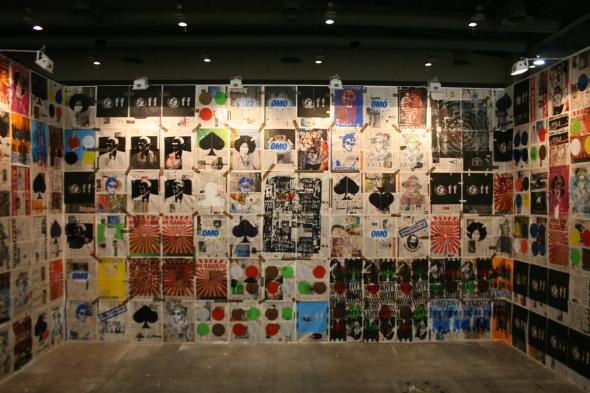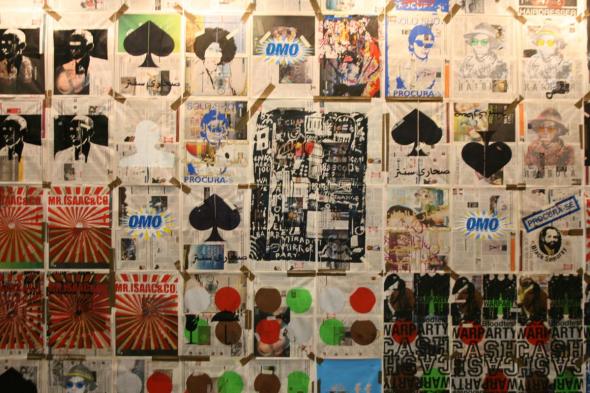Tania Candiani e Yonamine no Abrons Arts Center, em Nova Iorque.
 Yonamine, Dipolo, 2010.
Yonamine, Dipolo, 2010.
Exposições de Tania Candiani e Yonamine, que inauguram, hoje, 11 de Novembro, no Abrons Arts Center, em Nova Iorque, entre as 18H e as 20H. Estas exposições integram a programação do Abrons Arts Center, instituição na qual Miguel Amado é comissário em residência.
Tania Candiani: From Floor Plans to Confection Patterns:
Apartment Houses in New York City, 1900-1914 November 12–December 4, 2010. Opening reception: Thursday, November 11 from 6pm to 8 pm. Upper Main Gallery: Abrons Arts Center, 466 Grand Street, New York, NY 10002
The Abrons Arts Center is proud to present From Floor Plans to Confection Patterns: Apartment Houses in New York City, 1900-1914, the first solo exhibition in New York City in five years by Mexican artist Tania Candiani, in the Upper Main Gallery. Candiani’s community-driven practice examines the political condition of social groups in consumer society, from women to immigrants to. In performances and participatory projects, she brings together the representation of the female body, craft traditions such as textiles, and high culture references in the form of texts in order to address the value systems and behavior patterns that generate collective identity. Her output comments on the ideological apparatus that frames class inequality and responds to the effects of capitalist principles in shaping the dominant vision of the world.
Candiani has recently been interested in the relationship between architecture and the experience of everyday life. A work that plays on this theme is Writers y Escritores [Writers and Novelists] (2009). She asked graffiti crews to paint the window facade of the Vasconcelos Library in Mexico City with the names of prominent novelists—from Cortazar to Tolstoy—with “bombs,” a type of graffiti signature that conveys opinionated messages through visually engaging designs. This year she created Otros Paseos. Otras Historias [Other Walks. Other Histories], proposing guided tours of Mexico City’s historical center supported on testimonies of its inhabitants. This work is inspired by Situationist dérives, and proposed an affective cartography of this area drawn from personal memories rather then on official narratives.
During 2010, Candiani has also been researching the “Classic 6,” a prominent example of New York City’s pre-World War I residential building boom. These apartment houses were built from the 1880s to the 1910s for the middle and upper classes, and are today among the most coveted, least available properties in Manhattan. Candiani has collected reproductions of floor plans, advertising captions and photographs of several “Classic 6” dating between 1900 and 1914, and has created different works motivated by them. On view are, for example, typewritten copies of the descriptions of the apartment houses alongside contemporary exterior views and hand-made garments based in their floor plans. Candiani examines a significant period of New York City’s urban planning, one that has marked the connection between taste trends and the spread of bourgeois ethics, and which is an allegory to the hegemonizing of a conservative lifestyle in the US.
Tania Candiani was born in Mexico City in 1974 and currently lives and works in Tijuana and New York City, where she has been artist-in-residence at the International Studio & Curatorial Program. Her recent solo exhibitions include Otros Paseos. Otras Historias (Lugar Cero, Mexico City, 2010); Tales and Other Nightmares (Kunsthaus Miami, Miami, 2009); Writers y Escritores (Biblioteca Vasconcelos, Mexico City, 2009); Battleground (with Regina Jose Galindo) (Rubin Center, University of El Paso, Texas, 2009). She has participated in several group exhibitions, of which the most recent are the I Trienal Internacional del Caribe (Santo Domingo, Dominican Republic, 2010); Ready Media. Arqueología de los Medios y la Invención en Mexico (Laboratorio de Arte Alameda, Mexico City, 2010); Drawing the Line (Museum of Contemporary Art San Diego, CA, 2009); XI Cairo Biennial (2008); Viva Mexico (Zacheta National Art Gallery, Warsaw, 2007); Transactions: Contemporary Latin American and Latino Art (Museum of Contemporary Art San Diego, La Jolla, CA, 2006). She is currently working on a project for Laboratorio de Arte Alameda as well as a mid-career survey exhibition at Museo Carrillo Gil, both in Mexico City, in addition to a forthcoming publication including the past ten years of her production.
Yonamine: Dipoló
Charles E. Culpeper Gallery. November 12–December 4, 2010. Opening reception: Thursday, November 11 | 6–8 p. Abrons Arts Center. 466 Grand Street. New York, NY 10002
The Abrons Arts Center is proud to present the exhibition Dipoló, the US premiere of Angolan artist Yonamine, in the Charles E. Culpeper Gallery. Yonamine’s socially committed voice stands as a critical inquiry into the signs, ideas, and practices that constitute the ideological landscape of the global age. His output addresses the relationship between contemporary African iconography, colonial history, and identity politics. Bringing together his native country’s mythologies and Western narratives, he examines both the traumatic experience of Angola’s everyday life and the fragmented collective unconscious of a diasporic world.
Katchokwe Style (2009) is one of Yonamine’s most well-known works. He has covered the gallery floor with layers of sandbags, ranging in color from gold to brown, on which he has silkscreened portraits of different politicians, including George Bush and Samora Machel, and some Kinguilas, the women who exchange money in the streets). The installation poignantly evokes African and international events by replicating the setting of armed conflicts, of which the trench is a trademark, as well as the food supplies sent to African countries as humanitarian aid, two scenarios commonly associated with Africa that nevertheless result from past and present imperialist policies.
Yonamine has often employed the same silkscreening technique on newspaper pages, as is the case of Dipoló, the poster-like installation that he is showing in the Charles E. Culpeper Gallery’s display cases. “Dipoló” is an expression that refers to a diplomatic bag, and that is used by locals as a by-word for drug-running. Appropriately, Yonamine has assembled an engaging pop-driven imagery comprising brands of consumer goods like “Omo” and popular figures such as Razbula, the nickname of a young man whose source of income is the recycling of a state-owned national daily. With this work, Yonamine represents the grassroots lifestyle of most Angolans, who have to continuously develop underground, community strategies in order to live in a post-conflict society like that of Angola.
Yonamine was born in Luanda, Angola, in 1975, and currently lives and works in Lisbon, Portugal. Recent solo exhibitions include a Project Room at Zona Maco Sur in Mexico City, Control Z (Cristina Guerra Contemporary Art, Lisbon, 2009), Tuga Sauve (3+1 Arte Contemporânea, Lisbon, 2008), and Necessitat de Veure (Display Lab, Tarragona, Spain, 2007). He has participated in several group exhibitions, including the 29th São Paulo Biennial (2010), the X Havana Biennial (2009), the Sharjah Biennial 9 (2009), Listen Darling… The World is Yours (Ellipse Foundation Art Centre, Cascais, Portugal, 2008), Check List Luanda Pop (African Pavilion, 52nd Venice Biennale, 2007) and the 1st Luanda Triennial (2006-07).
 Yonamine, Dipolo, 2010.
Yonamine, Dipolo, 2010.
